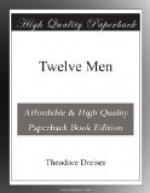A little later, if you please, it was Turkish rug-making on a small scale, the frame and materials for which he slowly accumulated, and then providing himself with a pillow, Turkish-fashion, he crossed his legs before it and began slowly but surely to produce a rug, the colors and design of which were entirely satisfactory to me. As may be imagined, it was slow and tedious work, undertaken at odd moments and when there was nothing else for him to do, always when the light was good and never at night, for he maintained that the coloring required the best of light. Before this odd, homely, wooden machine, a combination of unpainted rods and cords, he would sit, cross-legged or on a bench at times, and pound and pick and tie and unravel—a most wearisome-looking task to me.
“For heaven’s sake,” I once observed, “couldn’t you think of anything more interestingly insane to do than this? It’s the slowest, most painstaking work I ever saw.”
“That’s just it, and that’s just why I like it,” he replied, never looking at me but proceeding with his weaving in the most industrious fashion. “You have just one outstanding fault, Dreiser. You don’t know how to make anything out of the little things of life. You want to remember that this is an art, not a job. I’m discovering whether I can make a Turkish carpet or not, and it gives me pleasure. If I can get so much as one good spot of color worked out, one small portion of the design, I’ll be satisfied. I’ll know then that I can do it, the whole thing, don’t you see? Some of these things have been the work of a lifetime of one man. You call that a small thing? I don’t. The pleasure is in doing it, proving that you can, not in the rug itself.” He clacked and tied, congratulating himself vastly. In due course of time three or four inches were finished, a soft and yet firm silky fabric, and he was in great glee over it, showing it to all and insisting that in time (how long? I often wondered) he would complete it and would then own a splendid carpet.
It was at this time that he built about him in Newark a structure of friendships and interests which, it seemed to me, promised to be for life. He interested himself intensely in the paper with which he was connected and although he was only the cartoonist, still it was not long before various departments and elements in connection with it seemed to reflect his presence and to be alive with his own good will and enthusiasm. Publisher, editor, art director, managing editor and




